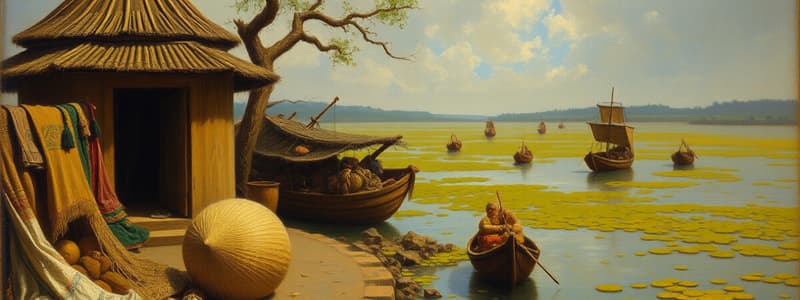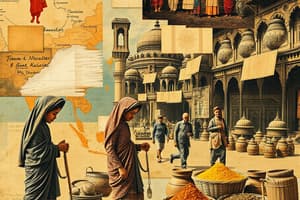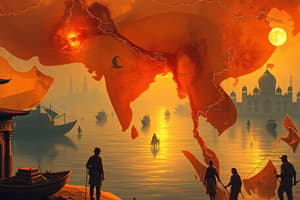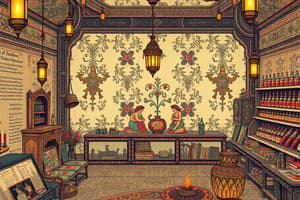Podcast
Questions and Answers
What was the main reason for European countries to search for sea-routes to India in the late 15th century?
What was the main reason for European countries to search for sea-routes to India in the late 15th century?
- The interest in spreading Christianity in Asia.
- A desire to find new spices in the Americas.
- The establishment of a strong European navy.
- The disruption of land trade routes due to the rise of the Turks. (correct)
Who was the first European explorer to successfully reach India and establish a sea route?
Who was the first European explorer to successfully reach India and establish a sea route?
- Bartolomeo Dias
- Vasco da Gama (correct)
- Ferdinand Magellan
- Christopher Columbus
What was the general attitude of the Mughal emperors toward European traders during the time of Vasco da Gama's arrival?
What was the general attitude of the Mughal emperors toward European traders during the time of Vasco da Gama's arrival?
- They negotiated exclusive trading rights with only the Portuguese.
- They were indifferent and did not consider them a threat. (correct)
- They viewed them as a significant threat and prepared their military.
- They sought alliances with European countries to counter regional powers.
Which of the following factors allowed the Portuguese to monopolize Indian trade in the 16th century?
Which of the following factors allowed the Portuguese to monopolize Indian trade in the 16th century?
What was the name of the ruler of Calicut with whom Vasco da Gama established friendly relations?
What was the name of the ruler of Calicut with whom Vasco da Gama established friendly relations?
How did the arrival of European traders affect the Mughal Empire in the 18th century?
How did the arrival of European traders affect the Mughal Empire in the 18th century?
Which European countries followed Portugal in making explorations and establishing trade routes to India after Vasco da Gama?
Which European countries followed Portugal in making explorations and establishing trade routes to India after Vasco da Gama?
What ultimately happened to the Mughal Empire in relation to European trading companies?
What ultimately happened to the Mughal Empire in relation to European trading companies?
What was the significance of Vasco da Gama's friendship with the ruler of Cochin?
What was the significance of Vasco da Gama's friendship with the ruler of Cochin?
What factor significantly contributed to the decline of Portuguese power in India by the end of the 16th century?
What factor significantly contributed to the decline of Portuguese power in India by the end of the 16th century?
What was the primary goal of the Dutch East India Company founded in 1602?
What was the primary goal of the Dutch East India Company founded in 1602?
Which event marked a significant concession granted to the English East India Company by Aurangzeb?
Which event marked a significant concession granted to the English East India Company by Aurangzeb?
What ultimately contributed to the transformation of the English East India Company from traders to rulers in India?
What ultimately contributed to the transformation of the English East India Company from traders to rulers in India?
How did the French East India Company differ from the English East India Company?
How did the French East India Company differ from the English East India Company?
What important transaction occurred with the marriage of Catherine of Braganza to King Charles II of England?
What important transaction occurred with the marriage of Catherine of Braganza to King Charles II of England?
Which of the following cities was NOT acquired by the Portuguese as part of their establishment in India?
Which of the following cities was NOT acquired by the Portuguese as part of their establishment in India?
What was a significant reason for the Dutch focus on Southeast Asia rather than India?
What was a significant reason for the Dutch focus on Southeast Asia rather than India?
What was the outcome of the failed attempt by Sir Josiah Child to capture Chittagong in 1685?
What was the outcome of the failed attempt by Sir Josiah Child to capture Chittagong in 1685?
Flashcards are hidden until you start studying
Study Notes
Indian Trade with the West
- Centuries-old trade between India and the West primarily involved spices, textiles, sugar, indigo, and saltpetre.
- The Arab traders controlled the trade routes, transporting goods from Indian ports to the Persian Gulf and Red Sea before overland delivery to Europe.
- The rise of the Turks in West Asia in 1453 disrupted established trade routes, prompting European nations to seek sea routes to India.
European Exploration and Arrival
- Vasco da Gama, in 1498, became the first European explorer to reach India, landing in Calicut after sailing around the Cape of Good Hope.
- His discovery established a direct sea route to India, attracting other European powers like the Dutch, British, and French for trade.
- Mughal emperors did not initially view Europeans as threats, allowing them to establish small trading settlements.
Decline of Mughal Power
- By the 18th century, regional powers in India began asserting independence, leading to changing dynamics in trade and power.
- European trading companies started to ally with local rulers, increasing their own power at the cost of the Mughal Empire.
The Portuguese in India
- The Portuguese were the first Europeans to set up a trading company in India, dominating trade in the 16th century due to their strong navy.
- Vasco da Gama established friendly relations with local rulers, and Albuquerque captured Goa in 1510, using it as headquarters.
- By the late 16th century, Portuguese power declined due to weak leadership and competition from Dutch and British companies.
The Dutch East India Company
- Founded in 1602, the Dutch East India Company emerged as a strong trading power in the 17th century.
- The Dutch broke the Portuguese monopoly in the Indian Ocean and established key trading centres but later focused on settlements in Southeast Asia.
- The British capitalized on the Dutch's weakened position, gradually diminishing their influence in India.
The British East India Company
- Founded in 1600, the English East India Company received a royal charter from Queen Elizabeth I to trade with India.
- In 1615, the British secured permission from Mughal Emperor Jahangir to establish a factory in Surat.
- Gradually expanded, the British created fortified factories, notably building Fort St. George in Madras and expanding into Bengal and Bombay.
Transformation from Traders to Rulers
- British officials initially focused on trade but shifted towards political control under Chairman Sir Josiah Child, who aimed to establish an empire in India.
- After a failed attempt to capture Chittagong, the Company faced setbacks but gained significant rights to trade and collect taxes from Mughal authorities.
- The growth of cities like Calcutta, Madras, and Bombay attracted Indian merchants, leading to British dominance in India.
French Presence in India
- The French East India Company, established in 1664, differed from the English version as it was state-controlled rather than privately owned.
- The French established fortified trading posts in Pondicherry and later expanded to Chandernagore and Mahe.
Acquisition of Bombay
- Bombay, originally consisting of seven islands, was acquired by the Portuguese through the Treaty of Bassein.
- The British received Bombay as a dowry when Catherine of Braganza married King Charles II, who transferred it to the English East India Company in 1668.
Studying That Suits You
Use AI to generate personalized quizzes and flashcards to suit your learning preferences.




